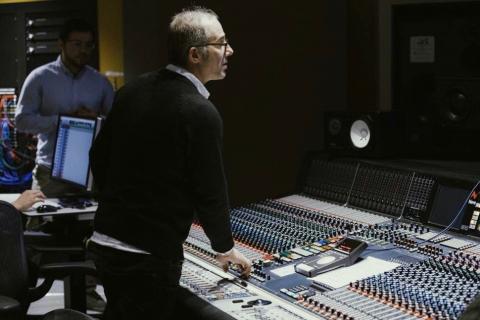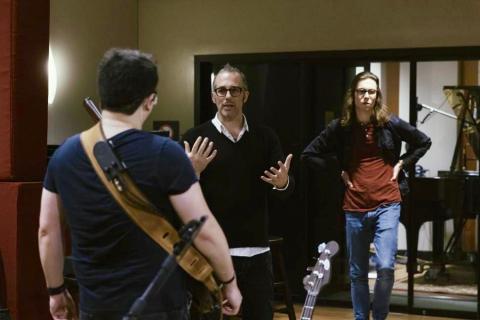‘I Need It with Fire’: A Day in the Studio with Joel Hamilton

Grammy-nominated producer and engineer Joel Hamilton
Image by Adam Ridhwan

Joel Hamilton (center) discussing song arrangements with Cotones bassist and current student Brad Williamson (left) and lead singer Luke Frees B.M. '19 (right)
Image by Adam Ridhwan
Grammy-nominated producer and engineer Joel Hamilton, who visited Berklee this fall, communicates most effectively in extravagant metaphors:
- “See if you can get 15 percent dumber on the next take.”
- “I need it with fire."
- “Float this last chorus, whatever that means to you.”
- “We need to step down into the verse.”
- “Don’t do what everybody does and sound like you were pushed off the Brooklyn Bridge."
Throughout his open studio session in Berklee’s Shames Family Recording Stage, it was clear that the visiting producer was in pursuit of a vision, one that was often more easily understood in figurative terms rather than literal ones. Hamilton was laser-focused on working with the band to achieve the clearest, most focused version of their composition possible. Often, this required describing what a part should feel like, or sound like, rather than precisely how it should be performed.
Hamilton’s intuition for developing focused “musical gestures” might explain his impressive and diverse discography. His production and engineering credits range from projects with rock 'n' roll stalwarts Iggy Pop, Elvis Costello, and Tom Waits; to reggae/hip-hop crossover act Matisyahu; to bedroom indie icon Sparklehorse; to Latin Grammy nominees Bomba Estéro, and many others. His weeklong visit to Berklee’s Music Production and Engineering Department was the semester's first in a series of visits by prominent producers and engineers that will continue throughout the year.
The week culminated in an all-day studio session with resident alumni rock 'n' roll shape-shifters the Cotones. The band was previously recruited for a raw and heavy studio session with legendary punk producer Steve Albini, but to this session they brought a more eclectic and intricate tune, one well-suited to Hamilton’s critical ear and his more active role as a producer.
Listen to the Cotones dissect their Steve Albini-produced track, "The Final Cut," on Sounds of Berklee:
“Working with Joel was an amazing experience for the band,” said Cotones lead guitarist and backing vocalist Ryan Bale B.M. ’19. "He dove headfirst into the song and really helped us tighten up the arrangement and overall flow so that the song lying underneath the arrangement could shine.”
Lead singer and pianist Luke Frees expanded on Bale’s take:"[Hamilton's] outside perspective made us focus on the song as it will appear to the listener, rather than the musicians playing it. And his feedback isn’t going to be limited to this song only—I know we'll take the points he gave us and think about them as we arrange other songs in the future.”
The band weren’t the only ones who benefitted from Hamilton’s insight, though. The studio control room was packed with MP&E students observing and assisting the producer throughout the day, and regularly interjecting with questions about his process and techniques.
Hamilton's studio tips ranged from highly concrete and specific (how does he mic the guitar amp?—with one Shure SM-7) to broad and philosophical. Perhaps the most memorable lesson of the day came in response to a question about the ambient room microphones Hamilton had set up around the room. His response had to do with a core tenet of his production approach: that a song ultimately gets shaped into its final form in the studio, and that it’s good to have the options and flexibility afforded by using more microphones than you might actually keep in the final mix. The room microphones could give the drums a sense of space, and of “heft,” which he might want for a certain part of the song. But of course, it was by way of another metaphor that he explained all this: “If I’m going to have a school bus jump the canyon, I’m going to film it with twenty cameras, and then decide later."




